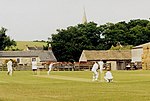Fairburn, North Yorkshire
Civil parishes in North YorkshireSelby DistrictUse British English from February 2020Villages in North Yorkshire

Fairburn is a small village and civil parish in North Yorkshire, England. Situated approximately 10 miles (16 km) east of Leeds, the village lies close to the A1(M) motorway and the M62 motorway and until 2005, when the A1(M) motorway was opened, Fairburn was divided in two by the old A1 and the two sides of the village were connected by just one vehicle bridge and one pedestrian footbridge, both of which have subsequently been removed.
Excerpt from the Wikipedia article Fairburn, North Yorkshire (License: CC BY-SA 3.0, Authors, Images).Fairburn, North Yorkshire
Caudle Hill,
Geographical coordinates (GPS) Address Nearby Places Show on map
Geographical coordinates (GPS)
| Latitude | Longitude |
|---|---|
| N 53.7458 ° | E -1.2865 ° |
Address
Caudle Hill
Caudle Hill
WF11 9JL
England, United Kingdom
Open on Google Maps










